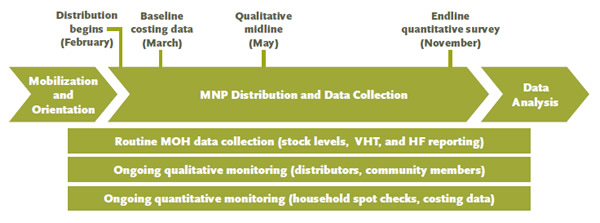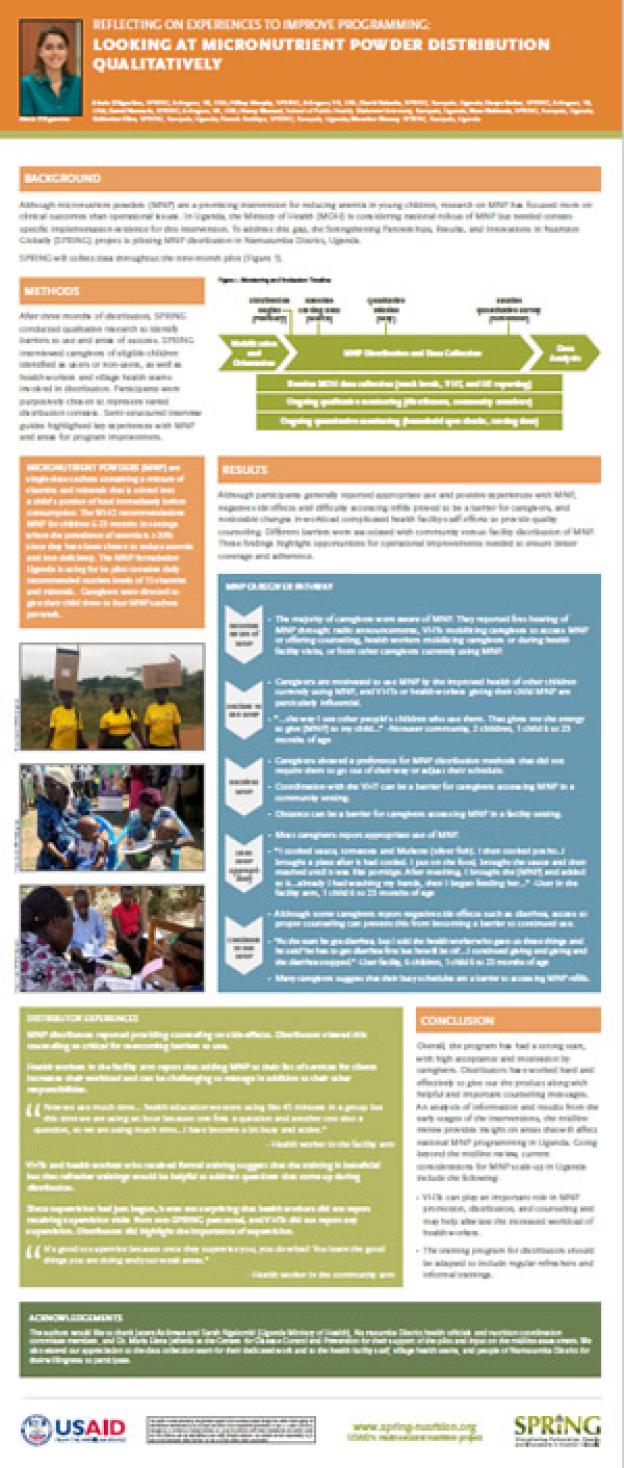Reflecting On Experiences To Improve Programming:
Background
Although micronutrient powders (MNP) are a promising intervention for reducing anemia in young children, research on MNP has focused more on clinical outcomes than operational issues. In Uganda, the Ministry of Health (MOH) is considering national rollout of MNP but needed context-specific implementation evidence for this intervention. To address this gap, the Strengthening Partnerships, Results, and Innovations in Nutrition Globally (SPRING) project is piloting MNP distribution in Namutumba District, Uganda.
SPRING will collect data throughout the nine-month pilot (Figure 1).
Methods
After three months of distribution, SPRING conducted qualitative research to identify barriers to use and areas of success. SPRING interviewed caregivers of eligible children identified as users or non-users, as well as health workers and village health teams involved in distribution. Participants were purposively chosen to represent varied distribution contexts. Semi-structured interview guides highlighted key experiences with MNP and areas for program improvement.
Mironutrient Powders (MNP) are single-dose sachets containing a mixture of vitamins and minerals that is stirred into a child’s portion of food immediately before consumption. The WHO recommendations MNP for children 6-23 months in settings where the prevalence of anemia is >20% since they have been shown to reduce anemia and iron deficiency. The MNP formulation Uganda is using for its pilot contains daily recommended nutrient levels of 15 vitamins and minerals. Caregivers were directed to give their child three to four MNP sachets per week.
Figure 1. Monitoring and Evaluation Timeline

Results
Although participants generally reported appropriate use and positive experiences with MNP, negative side effects and difficulty accessing refills proved to be a barrier for caregivers, and noticeable changes in workload complicated health facility staff efforts to provide quality counseling. Different barriers were associated with community versus facility distribution of MNP. These findings highlight opportunities for operational improvements needed to ensure better coverage and adherence.
MNP Caregiver Pathway
Becomes aware of MNP
- The majority of caregivers were aware of MNP. They reported first hearing of MNP through: radio announcements, VHTs mobilizing caregivers to access MNP or offering counseling, health workers mobilizing caregivers or during health facility visits, or from other caregivers currently using MNP.
Decides to use MNP
- Caregivers are motivated to use MNP by the improved health of other children currently using MNP, and VHTs or health workers giving their child MNP are particularly influential.
- ”…the way I see other people’s children who use them. That gives me the energyto give [MNP] to my child...” -Nonuser community, 2 children, 1 child 6 to 23 months of age
Receives MNP
- Caregivers showed a preference for MNP distribution methods that did not require them to go out of their way or adjust their schedule.
- Coordination with the VHT can be a barrier for caregivers accessing MNP in a community setting.
- Distance can be a barrier for caregivers accessing MNP in a facility setting.
Uses MNP appropriately
- Most caregivers report appropriate use of MNP.
- “I cooked sauce, tomatoes and Mukene (silver fish). I then cooked posho... I brought a plate after it had cooled. I put on the food, brought the sauce and then mashed until it was like porridge. After mashing, I brought the [MNP] and added to it...already I had washing my hands, then I began feeding her…” -User in the facility arm, 1 child 6 to 23 months of age
Continues to use MNP
- Although some caregivers report negative side effects such as diarrhea, access to proper counseling can prevent this from becoming a barrier to continued use.
- “At the start he got diarrhea, but I told the health worker who gave us these things and he said ‘he has to get diarrhea first but he will be ok’…I continued giving and giving and the diarrhea stopped.” -User facility, 6 children, 1 child 6 to 23 months of age
- Many caregivers suggest that their busy schedules are a barrier to accessing MNP refills.
Distributor Experiences
MNP distributors reported providing counseling on side-effects. Distributors viewed this counseling as critical for overcoming barriers to use.
Health workers in the facility arm report that adding MNP to their list of services for clients increases their workload and can be challenging to manage in addition to their other responsibilities.
Now we use much time… health education we were using like 45 minutes in a group but this time we are using an hour because one fires a question and another one also a question, so we are using much time…I have become a bit busy and active.
--Health worker in the facility arm
VHTs and health workers who received formal training suggest that the training is beneficial but that refresher trainings would be helpful to address questions that come up during distribution.
Since supervision had just begun, it was not surprising that health workers did not report receiving supervision visits from non-SPRING personnel, and VHTs did not report any supervision. Distributors did highlight the importance of supervision.
It’s good to supervise because once they supervise you, you do what? You learn the good things you are doing and your weak areas.
--Health worker in the community arm
Conculsion
Overall, the program has had a strong start, with high acceptance and motivation by caregivers. Distributors have worked hard and effectively to give out the product along with helpful and important counseling messages. An analysis of information and results from the early stages of the interventions, the midline review provides insight on areas that will affect national MNP programming in Uganda. Going beyond the midline review, current considerations for MNP scale-up in Uganda include the following:
- VHTs can play an important role in MNP promotion, distribution, and counseling andmay help alleviate the increased workload of health workers.
- The training program for distributors should be adapted to include regular refreshers and informal trainings.
